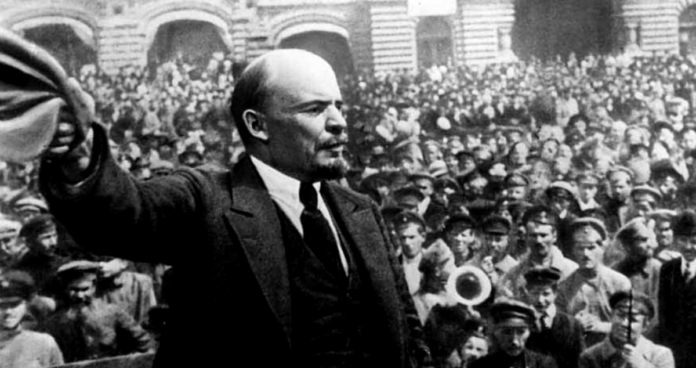January 21, 2024 marked the 100th anniversary of the death of Vladimir Ilyich Ulyanov, popularly known as Lenin. Lenin was a leader of the Bolshevik Party which oversaw the Russian Revolution in 1917. The Russian Revolution was a decisive turning point in world history, where for the first time working people established their own system of democratic rule through the “Soviets,” literally councils of workers, soldiers, and peasants.
Picking up the mainstream papers on the 21st, however, would have given you quite a different idea of who Lenin was and what his legacy represents. Capitalist apologists respond to Lenin’s legacy with frothing-at-the-mouth vitriol. Take the billionaire-owned Wall Street Journal’s testimonial, “A Century After Lenin’s Death, His Evil Legacy Lives On.” In it, David Satter paints Lenin as a demonic figure representing lawlessness, amorality, and terrorism.
Unlike the Wall Street Journal, socialists want to end the horrors of capitalism such as war, climate destruction, oppression, exploitation of workers, and imperialism. So we look at Lenin in quite a different light.
Russian Revolution
A question arises: if Lenin was the manifestation of evil Satter presents him as, how was he able to win popular support to carry out a revolution? Satter writes that the Bolshevik Party “was able to triumph in a country of more than 100 million because it was a machine of concentrated power that accepted murder and glorified it as a moral obligation.”
The reality is quite different. The Russian Revolution was directed against the rotten legacy of Tsarism, which had plunged millions of workers and peasants into the horrors of World War I (in which capitalists accepted murder and glorified it as a moral obligation.) The Tsar was overthrown in the February revolution of 1917, but the resulting provisional government ignored the masses, plunging them deeper into the war.
During 1917, the Bolsheviks won popular support of the masses in Russia because of their demands, in particular the rallying cry of “Peace, Land, and Bread.” This paved the way for the second, October revolution later in the year. The revolutionary government that resulted was based on workers’ democracy through Soviets: democratic councils set up by the workers and soldiers in the course of the revolution.
Civil War
Contrary to ruling class apologia, the October Revolution was mostly bloodless. However, the capitalists, backed by 21 imperialist armies, inflicted a deadly civil war that lasted 5 years and killed over 7 million. The imperialist-backed counter-revolutionary White Army were the main aggressors in the war, unleashing a terror campaign of anti-Semitic pogroms in order to restore the capitalists’ privileges. This put the new workers’ state through ferocious test of its resilience against capitalist and imperialist reaction.
Satter’s portrayal of Lenin as a bloodthirsty maniac is pure nonsense. Nonetheless, Lenin was no pacifist. He saw clearly that when the masses of working people fight back, the ruling class will clamp down with every violent weapon at its disposal. Anyone who has seen police use tear gas and rubber bullets, break up strikes, and arrest peaceful protesters knows this truth all too well. Lenin’s answer to this was to have no illusions in the capitalist class’ willingness to “peacefully” hand over their power and profits; only a genuine mass movement backed by the majority of workers, armed with a program for collective welfare, can carry out and defend socialist change.
Lenin was no stranger to the claims of “amorality” in his lifetime. But he saw clearly that the deadly system of capitalism itself was the root of countless evils in society, and thus the underlying class struggle must be brought to the fore. As Trotsky wrote in Their Morals and Ours, “Lenin refused to recognize moral norms established by slave-owners for their slaves and never observed by the slave-owners themselves; he called upon the proletariat to extend the class struggle into the moral sphere too.”
Stalinism vs. Bolshevism
Much of the hostility to Lenin and the Bolsheviks involves back-tracking the crimes of Stalin onto Lenin. However, Stalin waged a bureaucratic counter-revolution against the Bolsheviks that Lenin campaigned against until his last breath.
The Bolsheviks never expected that socialism could be achieved in isolation in a single country, especially a semi-feudal country ravaged by years of war. They looked to the revolutionary upheavals that took place in Europe for support. When these revolutions were crushed, Russia was isolated, allowing a bureaucracy to develop.
In spite of Satter’s claims that “Lenin viewed the past with a degree of detachment in the last months of his life,” he had actually been blocking with Trotsky to challenge Stalin’s growing bureaucracy. Following Lenin’s death, this struggle was continued by Trotsky and the Left Opposition. This is the tradition we stand in.
Why Lenin’s Legacy Matters
Capitalism can’t offer working people what we need – whether it’s healthcare, housing, or decent jobs. Worse, it’s continuing to spiral the world into crisis. Just as in Lenin’s time, ordinary people around the world are being thrown into the meat grinder of imperialist war. Meanwhile, Oxfam predicts the world will see its first trillionaire within the next decade.
Something has to change, and radically. But how can working people and the oppressed of the world possibly stand a chance against the global superpowers, the multinational corporate empires, the billionaires, the police and armies, and the bosses who wring us out for profit every day?
This question is what Lenin dedicated his life to learning, and his guidance on these questions should be studied seriously by anyone who wants to organize for system change today. It is exactly why his legacy is feared by the likes of the super-rich and the Wall Street Journal. We stand unequivocally for the goal of building a movement of workers, youth, and oppressed people to carry on not only Lenin’s legacy, but that of every person in history who has ever dared to fight for a better world.


